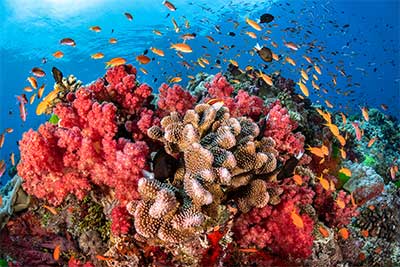Date : 04/07/2023
Relevance: GS-3: Economic Development, Biodiversity, and Environment.
Key Words: UN High Seas Treaty, Earth's habitable space, marine protected areas, climate mitigation, habitable space, climate mitigation.
Context–
The recently agreed UN High Seas Treaty aims to safeguard 30% of international waters by 2030. Oceans cover 71% of Earth's surface, acting as a vital carbon sink and mitigating climate change. Moreover, three billion people depend on marine ecosystems for sustenance and economic security. However, less than 7% of the ocean is protected, particularly the high seas, which remain largely lawless.
High Seas Treaty/Marine Biodiversity of Areas Beyond National Jurisdiction (BBNJ) Treaty Features
- Provision of funding to help developing countries implement the treaty.
- Clearing-house mechanism to be established.
- The draft also adds that no State can claim its right over marine genetic resources of areas beyond its national jurisdiction.
- It stipulates that marine resources in areas beyond national jurisdiction that are held by indigenous people and local communities can only be accessed with their “free, prior and informed consent or approval and involvement”.
- Environmental impact assessments need to be carried out before the exploitation of marine resources.
- Use and activities regarding marine genetic resources of areas on high seas should be in the interests of all States. It should be for the benefit of humanity.
- Set up an access- and benefit-sharing committee to frame guidelines.
- Demarcation, preservation and protection of marine protected areas (MPAs).
- Sustainable use of marine genetic resources and equitable sharing of benefits arising from them.
- EIA for all major activities in the oceans.
- Capacity building and technology transfer.
Vast Ocean –
High seas refer to ocean areas beyond any country's jurisdiction. They harbor rich marine biodiversity, including iconic species, and serve as essential habitat and migratory routes for whales, sharks, turtles, and seabirds. Remarkable ecosystems like seamounts and deep-water coral gardens thrive in the high seas.
The 30×30 Target:
Preserving at least 30% of the ocean (30×30) by 2030 is crucial for healthy marine ecosystems and global biodiversity. Existing marine protected areas (MPAs) cover only a tiny fraction of the ocean, with less than 1% in the high seas. Scientists emphasize the need for greater protection to sustain marine life.
Climate Change Impact:
Marine conservation through MPAs not only benefits biodiversity but also plays a vital role in climate regulation. Oceans absorb CO2 and excess heat, regulating temperatures and influencing global weather patterns. Protecting blue carbon ecosystems ensures the ocean continues to play its critical climate role.
Declining Whale Population:
Whales contribute significantly to carbon sequestration and phytoplankton activity, vital for oxygen production and CO2 capture. However, industrial whaling has drastically reduced whale populations, affecting phytoplankton activity and the ocean's carbon cycle.
Protecting and Restoring Biodiversity:
Establishing MPAs protects vulnerable species and ecosystems from overfishing and human activities. Reducing plastic waste prevents harm to marine species, while cutting greenhouse gas emissions mitigates climate change impacts on the oceans. Encouraging sustainable fishing practices helps minimize bycatch.
Conclusion:
The Biodiversity Beyond National Jurisdiction treaty represents a breakthrough in ocean protection, benefiting biodiversity and climate. Continued dedication from governments is essential for its successful implementation. Making high seas protection a priority will preserve the well-being of our planet and its ecosystems in the coming decades.
Probable Question for UPSC Mains:
- The UN High Seas Treaty, also known as the BBNJ Treaty, has significant implications for the protection of high seas and ocean biodiversity. Discuss the key features and provisions of the treaty and explain their importance. (10 Marks, 150 Words)
- The high seas, which comprise two-thirds of the world's ocean, remain largely lawless and unprotected. Elaborate on the significance of establishing marine protected areas (MPAs) in the high seas and their role in conserving marine biodiversity. (15 Marks, 250 Words)
Source – DTE







